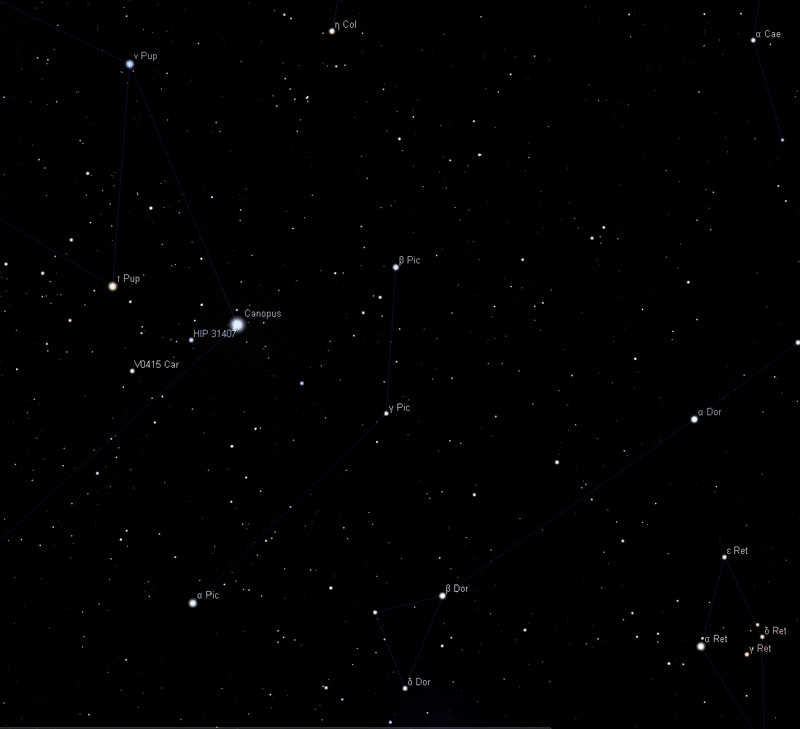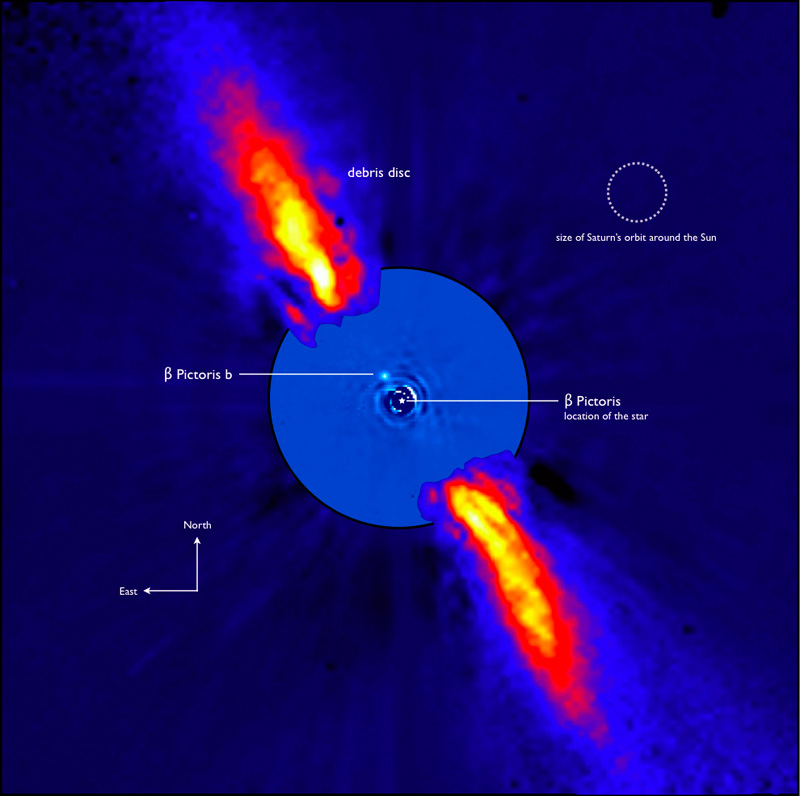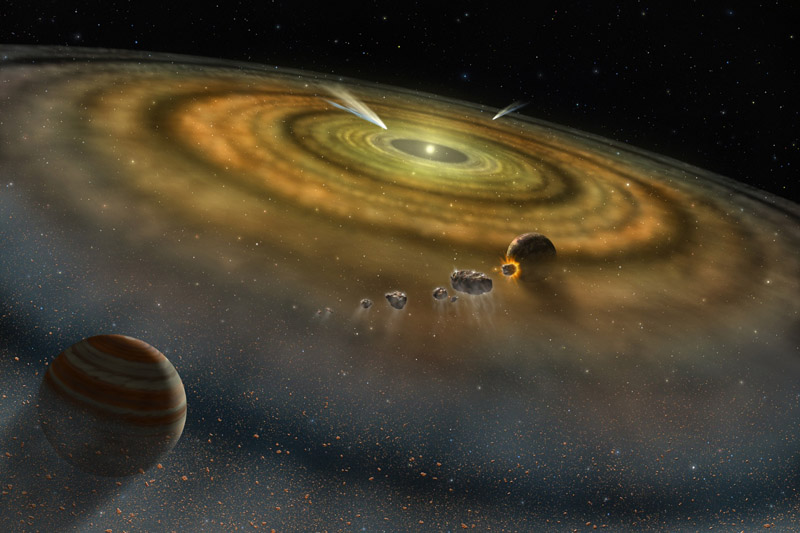DISCOVERY OF TWO FAMILIES OF EXOCOMETS AROUND THE STAR β PICTORIS
Astronomers discovered two families of extrasolar comets, or "exocomets" around the star β Pictoris. A first family consists of old exocomets, trapped in resonance with a massive planet and exhausted by their multiple passages near the star. The second family consists of exocomets likely arising from the recent fragmentation of one or a few larger objects. This result shows that the objects observed for a long time in the young planetary system of β Pictoris are analogous to the comets in our own Solar System.
Astronomers have identified nearly 2,000 extrasolar planets, or "exoplanets" : planets that orbit stars different from the Sun. In that context, the extrasolar system surrounding the star β Pictoris is one of the most studied because β Pictoris is a young star located close to the Sun: it is about 20 million years old and is located at 63 light years. Above all, it is surrounded by a huge disk that shows a very active young planetary system where gas and dust are produced by the evaporation of comets and the collisions of asteroids; this activity is similar to what happened in the Solar System when planets like the Earth were just forming. A giant planet, "β Pic b", in orbit at about eight astronomical units1 was also detected in high resolution images obtained with adaptive optics.
In addition to this planet, variations in the spectrum of β Pictoris are observed for almost 30 years; they are interpreted by the transit of comets in front of that star. Comets are small bodies of a few kilometers in size; they are rich in ices and volatiles, and they evaporate when they approach their star, producing gigantic tails of gas and dust. They are the frozen fossils of the early ages of their planetary system. That is why comets, especially those orbiting β Pictoris, provide evidence of the mechanisms that take place during the planetary formation and of the evolution of the planetary systems as a whole; it is also the reason why the module Philae of the Rosetta mission launched by the European Space Agency (ESA) will land on the comet Churyumov-Gerasimenko in November. For β Pictoris, the detailed observations of the comets provide important elements to understand the mechanisms at work in a young planetary system, and indirectly help us to understand what happened in the Solar System 4.5 billion years ago.
To observe the comets of β Pictoris, researchers at the Institut d'astrophysique de Paris (IAP), the Institut de radioastronomie millimétrique (IRAM), and the Institut de planétologie et d'astrophysique de Grenoble (IPAG) used the technique of "transits": the studied objects are observed when they pass in front of its star, producing a mini-eclipse. This technique has already been used to observe the atmospheres of exoplanets2. During the transit of an exocomet, the star light is partially absorbed, thereby allowing the measurement of the size and the speed of the cloud of gas surrounding the cometary nucleus.
To study the β Pictoris exocomets, Flavien Kiefer (IAP/CNRS/UPMC) and his team analyzed an homogeneous sample of over 1000 spectra obtained between 2003 and 2011 on the 3.6 meter telescope of the European Southern Observatory (ESO). In these spectra, astronomers have identified 6,000 signatures of exocomets. Some exocomets were observed several times and for a few hours. Finally, for their statistical analysis the researchers selected a sample of 493 different exocomets. For these objects, the analysis provided the measurements of the speed and the size of the gas clouds, and indirectly the distance to the star and the orbital properties of each of these exocomets as the eccentricity or the orientation of the orbit.
This analysis of several hundreds of exocomets in a single planetary system is unique. It revealed the presence of two distinct families of exocomets: one family of old exocomets trapped in orbits in resonance with a massive planet, and another family, probably arising from the recent breakdown of one or a few bigger objects.
The exocomets of the first family are on various orbits and show a rather weak activity with low production rates of gas and dust. This suggests that these comets have been exhausted in volatiles by their multiple passages near β Pictoris. Moreover, the orbits of these comets (eccentricity and orientation) are exactly as predicted for comets trapped in orbital resonance3 with a massive planet. The properties of the comets of the first family show that this planet in resonance must be at less than about ten astronomical units, i.e. where the planet β Pic b was discovered.
The exocomets of the second family are much more active. Moreover, these exocomets are on nearly identical orbits, like the comets of the Kreutz family in the Solar System, or the fragments of the comet Shoemaker-Levy 9, which impacted Jupiter in July 1994. This suggests that the exocomets of the second family all arise from the same origin: probably the breakdown of a larger object whose fragments are on an orbit grazing the star β Pictoris.
In summary, for the first time a statistical study has determined the physical and the orbital properties of a large number of extrasolar comets, or "exocomets", which have been analyzed as a whole. This study provides an original and unprecedented vision of the mechanisms at work in a young planetary system that resembles our own Solar System just after its formation 4.5 billion years ago.
1The astronomical unit (symbol au) is a unit of distance that is approximately the Earth-Sun distance. The value of the astronomical unit is exactly 149,597,870.7 kilometers.
2Observing the atmosphere of transiting exoplanets, astronomers have discovered the evaporation of the gaseous giant planets orbiting very close to their star (European
astronomers observe first evaporating planet; www.spacetelescope.org/news/heic0303/), they have measured the composition, the
pressure and the temperature of the atmosphere, and then calculated the colors of the sky of one of these planets (a cyan disc in a purple sky sunset on Osiris; www.insu.cnrs.fr/univers/les-exoplanetes/un-disque-cyan-dans-un-ciel-pourpre-coucher-de-soleil-sur-
osiris (in french), and they also observed weather phenomena ("Dramatic change spotted on a faraway planet"; www.spacetelescope.org/news/
heic1209/).
3Two bodies in orbit around a star or a planet are in mean-motion orbital resonance when the ratio of their orbital period is an integer or a ratio of integers. For
example, Neptune and Pluto are in resonance 3:2: when Neptune makes three turns around the Sun, Pluto makes exactly two. For the exocomets of β Pictoris the resonance 4:1 is considered: the exocomets
make four turns around the star when the massive planet makes one.
See the European Southern Observatory (ESO) Press Release: Two Familes of Comets Found Around Nearby Star - Biggest census ever of exocomets around Beta Pictoris
Reference
The team of astronomers who made this study is composed of: F. Kiefer1, A. Lecavelier des Etangs1, J. Boissier2, A. Vidal-Madjar1, H. Beust3, A.-M. Lagrange3, G. Hébrard1, & R. Ferlet1.
1Institut d'astrophysique de Paris, CNRS, Université Pierre & Marie Curie-Paris 6, Paris, France
2Institut de radioastronomie millimétrique, Saint Martin d'Hères, France
3Institut de planétologie et d'astrophysique de Grenoble, CNRS, Université Joseph Fourrier-Grenoble 1, Grenoble, France
The study is presented in a paper entitled "Two families of exocomets in the Beta Pictoris system" which will be published in a forthcoming issue of Nature.
Acknowledgments
This study was based on observations made with ESO telescopes at the La Silla Observatory and data obtained from the ESO Science Archive Facility. This work has been supported by an award from the Fondation Simone et Cino Del Duca. The authors also acknowledge support from the French Agence Nationale de la Recherche (ANR), under programmes ANR-12-BS05-0012 (Exo-Atmos) and ANR-2010 BLAN-0505-01 (ExoZodi).
Contacts
Alain Lecavelier des Étangs
Institut d'astrophysique de Paris-CNRS-UPMC
lecaveli at iap.fr
Tél. : 33-1-4432-8077
Flavien Kiefer
Institut d'astrophysique de Paris-CNRS-UPMC
School of Physics and Astronomy, Tel Aviv University, Israël
kiefer at iap.fr
Tél. : 972-502-838-163
Illustrations

The sky toward β Pictoris: this star is visible with naked eye in the south hemisphere sky (image made with the Stellarium software, see www. stellarium.org)

The planet β Pic b and the dust disk around the star β Pictoris
© : ESO/A.-M. Lagrange et al.

Artist's conception of the β Pictoris disk
© NASA/FUSE/Lynette Cook

Image of Shoemaker-Levy 9
© NASA, ESA, and H. Weaver and E. Smith (STScI)

Shoemaker-Levy 9 and Jupiter
© NASA, ESA, H. Weaver and E. Smith (STScI) and J. Trauger and R. Evans (NASA's Jet Propulsion Laboratory)
October 2014
